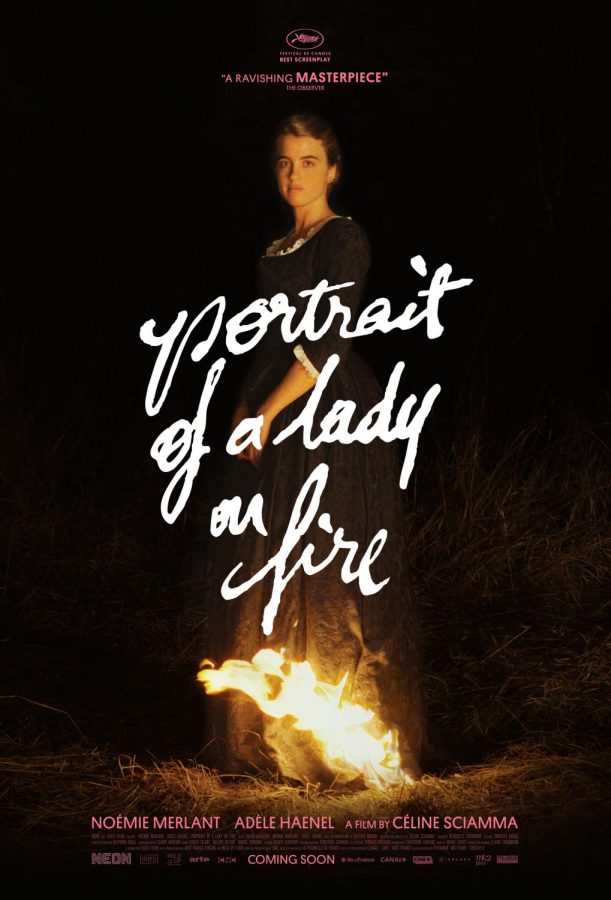‘Portrait of a Lady on Fire’ sets the patriarchal roots of the film industry ablaze
“Portrait of a Lady on Fire” follows a young aspiring painter named Marianne in 18th century France.
April 1, 2020
In this day and age, it’s not easy for a female director to write and direct a film — let alone one that solely revolves around a lesbian relationship and features no men whatsoever for the bulk of the story.
Lesbian representation is scarcely found in cinema and global film industries still largely considered it taboo. With Céline Sciamma’s fourth film, “Portrait of a Lady on Fire,” now streaming on Hulu, she not only injects new life into this suppressed genre of films, but also reconstructs audience perspective by re-examining the “male gaze.”
In her exploration into the artistic sensibilities of the gaze, Sciamma takes us to 18th-century France, years before the French Revolution, where we follow a young aspiring painter, Marianne, who travels to a male-destitute island off the coast of Brittany.
Residing in a quaint “maison de ville” on the island is a wealthy Italian countess and her young daughter, Héloïse, who is in need of a self-portrait to be sent to a wealthy suitor in Milan. The countess informs Marianne of Héloïse’s capricious nature and ill feelings toward the marriage, especially as we learn that her older sister had originally been betrothed to the Milanese nobleman, but had killed herself in contempt for the marriage.
To avoid further transgressions, the countess suggests that Marianne masquerade herself as a walking companion to closely admire Héloïse’s features and secretly transcribe them to canvas.
As such, Sciamma spends a significant portion of the film enveloping us in the fervent, unspoken exchanges between Marianne and Héloïse during their serene walks by the cliffs.
All that’s left is the diegetic sounds of crashing waves and swift sea gusts, as we passively observe the pair make small talk through their mouths, but embrace one another through their longing eyes.
It’s during these walks that Marianne slowly begins to question what was, at first, a mutual sympathy for Héloïse’s situation, but has now spiralled into a looming temptation for her.
Upon finishing her first portrait, Marianne is forced to reveal her true intentions as a painter — and is met with Héloïse’s fury. In response, Héloïse offers a disdainful criticism of her work, leading Marianne to disfigure the painting.
The countess prepares to dismiss Marianne until Héloïse comes to her side and claims she deserves a second chance, conceding that she will be much more compliant this time around out of respect for Marianne’s actions.
The two eventually acknowledge their mutual romantic feelings for one another and explore the new terrains of their relationship both physically and emotionally, all while Marianne attempts to capture the true essence of Héloïse in her second portrait.
Lesbian cinema for decades has been mishandled and contorted by heterosexual men to fit what film scholar Laura Mulvey first described in the 1970s as the “male gaze.” In what was a breakthrough for gender politics and feminism in film, she controversially argued that traditional Western depictions of women in Hollywood cinema are centered on fulfilling the voyeuristic sensibilities and sexual gratification of men. In other words, the sole function of female representation was to conform to the heterosexual male gaze.
How this has traditionally translated to male-directed lesbian films of the past has been an over-sexualized, almost pornographic, representation of women and lesbian relationships. Female characters are often framed through the camera in desirable ways from a male perspective, and attraction is often conveyed exclusively through sexual pleasure in the form of frequent sex scenes that pronounce the female body in an objectifying manner.
This is the case in critically acclaimed films such as “Mulholland Drive” and “The Handmaiden,” which navigate quite complex narratives, but present their female characters through a voyeuristic lens.
Sciamma, however, being an openly lesbian filmmaker, shows a self-awareness of the male gaze in her film by offering a different perspective — one that literally and figuratively focuses on the female gaze and attempts to reconstruct how we perceive desire through cinematic language.
“Portrait of a Lady on Fire” strips sex scenes of visual pleasure, and heavily attempts to underplay what would be conventionally attractive within the patriarchal social structure in these rather intimate moments. This is apparent in scenes where Marianne and Héloïse would kiss, and we would expect a sex scene to follow, but instead Sciamma cuts afterward to both of them lying in bed, passionately looking at one another.
She particularly angles the camera in ways that aren’t exploitative of the characters’ bodies on screen, placing features antithetical to the male gaze, like armpits and stomachs, center frame. But most essentially, Sciamma dials into the transience of every moment, completely eradicating sound and motion from the diegetic space to permeate the inevitability of time and the impermanence of their relationship.
The interlocked gaze that Marianne and Héloïse share symbolizes more than a mutual attraction, but the breaking of a patriarchal barrier, akin to how Marianne sees Héloïse for more than just a pretty face in a painting. It’s a transcendence of Héloïse’s objectification, which she is fatalistically bound to experience in her marriage — but through her role as “an object to be looked at,” we are forced to reflect on the nature of our gaze.
As Héloïse says to Marianne while she poses for the portrait, “If you look at me, what do I look at?”



